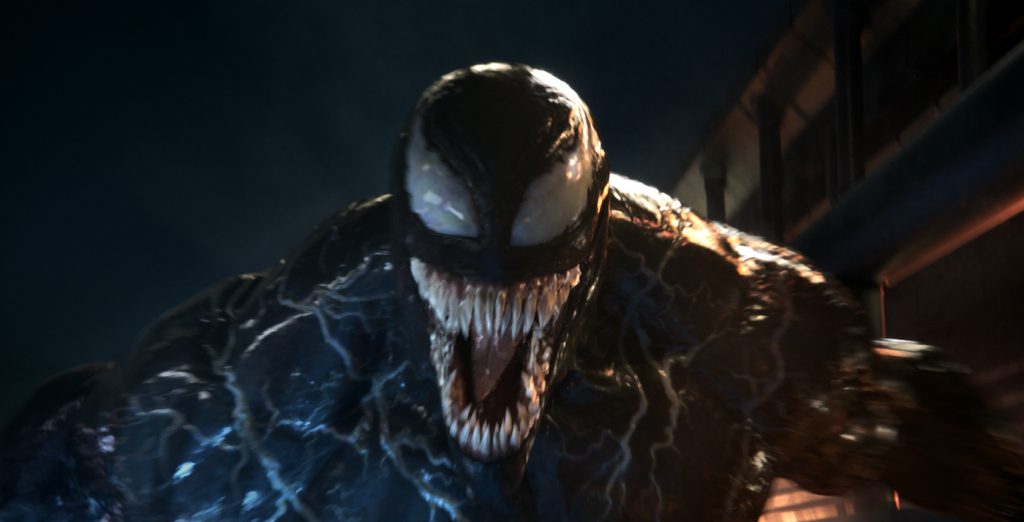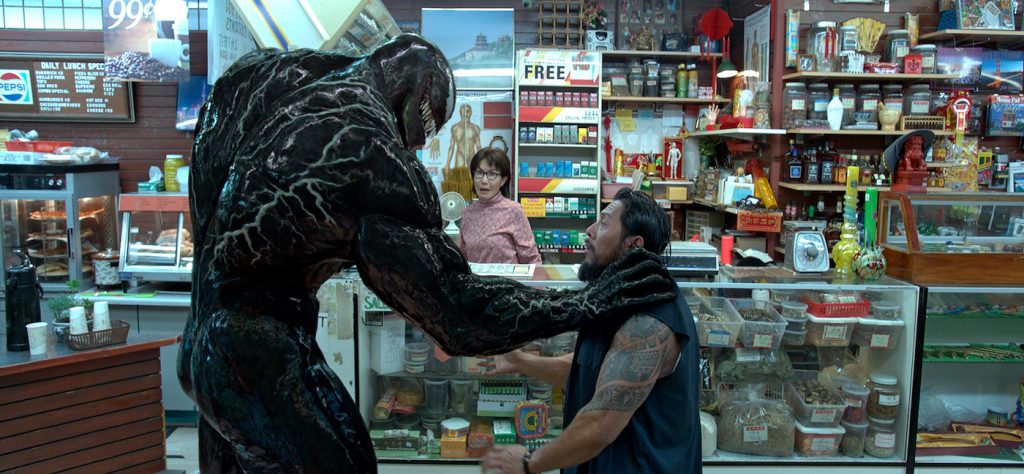VFX Artists Explain How They Made Venom Marvel’s Freakiest Character
For a superhero movie, Venom boasts an unusually strong cast of heavy hitters including Tom Hardy in the title role along with Michelle Williams and Riz Ahmed. But in this Marvel Comics-based story, it’s the visual effects that drive the spectacle by transforming Hardy’s ordinary human reporter Eddie Brock into a tentacle-sprouting “symbiote” freak. To learn more about CGI-powered monster mutations, The Credits checked in with the VFX company DNEG in London, where visual effects supervisor Paul Franklin (Captain America, The Dark Knight trilogy) and concept artist Paolo Giandoso (Ant-Man, Iron Man 3) discussed the art of goo, obsidian knives, and Clint Eastwood.

PAUL FRANKLIN, VISUAL EFFECTS SUPERVISOR, DNEG
How did Tom Hardy’s physical performance as normal human Eddie Brock inform your design of Venom?
Tom created an amazing physical performance for Eddie Brock. His movement and body language became the cornerstone for our VFX work — the way he held himself, the roll of his shoulders. The animation team took extended that performance into the dynamic superhuman range of Venom’s movement.
Venom comes fully loaded with gooey liquid. How did you create that effect?
From a technical point of view, the liquid was definitely the hardest thing. The FX animation team built on top of the work of the animation team, adding layers of viscous fluid movement that enhanced and extended the character’s performance. It took a long time to get right, but it was worth the effort.
Did you have real-world references in mind when you animated Venom’s tentacles?
Our key references were the organic movement of sea creatures and scientific demonstrations of unusual “non-Newtonian” fluids that we found online. This gave us a great place to start from. The animators took that into account when they created the underlying movement of the tentacles, using Tom Hardy’s performance as a starting point. From there, the FX team added layers of fluid goo movement to complete the effect.
How did you go about translating Venom’s crazy tongue from comic book page to movie screen?
In the comics Venom usually has his tongue out, curling into all sorts of expressive shapes, but that became a real issue for the animators because they needed Venom to deliver dialogue. After a lot of testing, they figured out how to work around the teeth by taking a [page] from movie stars like Jack Palance and Clint Eastwood, who sometimes deliver dialogue through clenched teeth. Rather than having the tongue be constantly present, we just used it for emphasis, and that gave the tongue more impact.
How did you use motion capture to create Venom, who’s about 21 inches taller than Tom Hardy?
We had a tall stunt double, about 6 foot 7 inches, who wore a helmet with a sight line target on top of it to take him up to Venom’s height, which we set at 7 foot six. We had two or three Canon 5D Mk III witness cameras on set, which were slated with timecode taken from the sound desk. The witness cameras gave us this great reference for the movement on set, and that allowed us to figure out exactly where things were. For example, when Eddie extrudes tentacles from his body, we needed super-precise tracking to make those shots work.

Can you break down that wild sequence where Eddie Brock first morphs into Venom?
Eddie starts the scene as this broken, battered victim of a high-speed crash. As the bad guy taunts him we see the Venom goo surging out over Eddie’s body, repairing his injuries as it does so. We spent a lot of time tracking Tom’s physical shape, right down to the folds of cloth in his costume, and we used a detailed line-up model for the basis of the goo effects. The FX team controlled the flow of the goo and created the sense of it soaking through Eddie’s clothes before coalescing into the beginnings of what will become Venom’s body. The legs and arms “unbreaking” were created with a detailed digital double of Tom that held up to close scrutiny. To complete the transformation we created multiple layers of FX simulations tracked to Tom’s body. The tricky part was making sure that it didn’t just look like a wetsuit closing over his head, so we added layers of distortion and individually animated the teeth as they move into place so that you’re not quite sure what’s happening until the effect is complete.
What was your process for putting together the car chase sequence where Venom stretches into the cars on either side of him?
The car chase started with detailed previs, which became the basis for a practical shot against blue screen. The VFX team added the traveling environment and put glass in the car windows. Animation and FX together created the webs of gooey tentacles holding the cars apart, until venom’s tentacles reach in and spin the cars off the road. At that point, everything becomes real again with that spectacular “double sidewinder” crash on the street location.
PAOLO GIANDOSO, CONCEPT ARTIST, DNEG
What kind of homework ahead of your Venom concept art?
I kind of cheated because my brother is a huge Venom fan and he introduced me to the “Lethal Protector” series, in Italian, during the 90’s. My main influences are the Mark Bagley drawings of Venom.
What do you consider the key to the Venom look?
My favorite element of the character is the disgusting drool that Venom leaves everywhere he goes. I made sure to draw it in all of my concepts because it’s so distinctive. I also looked at a lot of visual reference from animal predators like sharks and snakes to ground the character in reality.
How did you visualize Venom’s nemesis Riot?
I felt like Riot needed to be a darker, more feral reflection of Venom. I imagined Riot as the shattered mirror image of the protagonist so I made his shape language harsher, his teeth sharper and fang-like, and I made Riot’s claws longer, similar to obsidian knives.
What was your favorite part of the project?
For the final fight in the third act, I created this sequence of 158 images and the director and the VFX Supervisor reacted very well to it. I think drawings show a greater range of expressions than previs, so I was able to show the symbiotes stretching, tearing and morphing in crazy ways. I had great fun using this quick, semi-realistic style to express movement.
Featured image: Venom (2018). Courtesy Sony Pictures



